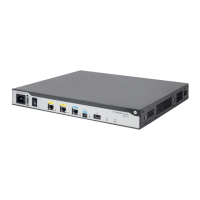14
[Router-GigabitEthernet2/0/1] ip address 192.168.20.99 255.255.255.0
# Enable common proxy ARP on interface GigabitEthernet 2/0/1.
[Router-GigabitEthernet2/0/1] proxy-arp enable
[Router-GigabitEthernet2/0/1] quit
Verifying the configuration
# Verify that Host A and Host D can ping each other.

